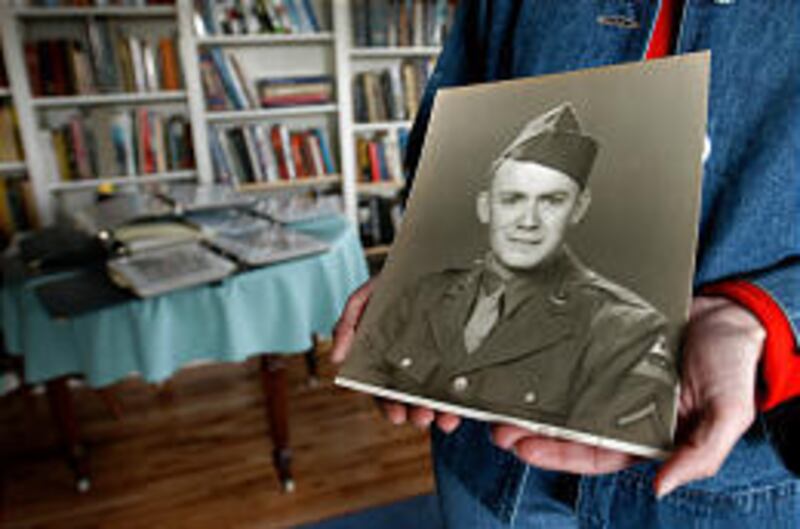The story of how America finally built a memorial to the greatest war in history begins not on a distant battlefield or in the halls of Congress but at the annual fish fry in Jerusalem Township, Ohio.
It was a cold night in February 1987. Marcy Kaptur had just loaded her plate with Lake Erie perch when a man's voice boomed across the room: "Hey, Congresswoman Kaptur! Why is there no World War II memorial in Washington?" Impossible, thought Kaptur, then a three-term Democrat. Then she had it: What about the big statue of the Marines raising the flag at Iwo Jima?
"No!" replied Roger Durbin. "That's a memorial to one service."
They sat and talked. And that year, Kaptur introduced legislation to create a National World War II Memorial in Washington.
But when the memorial opens to the public this month, 17 years will have passed since Kaptur's fish-fry epiphany. Only 4 million of the 16 million Americans who fought in the
war are still alive, and they are dying at a rate of 1,056 a day.
The memorial, which will be dedicated May 29 during Memorial Day weekend, is on the National Mall, between the Washington Monument and the Lincoln Memorial.
The granite and bronze memorial is slightly longer than a football field and has a sunken plaza that contains a pool and fountains. It is lined by 56 columns, one for each U.S. state and territory in 1945. Two arches 43 feet high representing the Atlantic and Pacific theaters flank the memorial. Its far wall bears a field of 4,000 gold stars, one for every 100 Americans killed in the war.
When President Clinton dedicated the memorial site in 1995, he thanked Durbin for showing "that an American citizen can have a good idea and take it to the proper authorities and actually get something done."
Durbin was a high school dropout from the rural village of Berkey, Ohio, who enlisted in 1943 at age 22, leaving behind a wife and young son. For Durbin, a tank mechanic with Gen. George Patton's Third Army, the war was hell.
He never forgot the sight of American soldiers' bodies piled like cordwood at the Battle of the Bulge or the emaciated survivors his unit found at the Nordhausen concentration camp in central Germany.
Durbin, who became a rural mail carrier, loved children but said he would have no more of his own. He didn't want to bring anyone into the world he'd seen.
After Durbin's fish-fry encounter with Kaptur, it took six years for Congress to pass Kaptur's bills authorizing the memorial and start-up funding. Then came the review process.
The World War II Memorial would need approval by six federal and local agencies, which would hold 22 public hearings and deliberate another eight years.
As the approval and design process ground on, Durbin repeatedly warned in speeches and letters that time was running out for World War II veterans: "We're dying like flies."
When his granddaughter, Melissa Growden, was appointed to the memorial advisory board, he was no easier on her.
"His frustration became so great that he became agitated, almost obsessive," says Growden, an architectural historian who lives in Toledo, Ohio.
He wasn't the only one. "People kept asking, 'What's wrong? Why can't we get this done?' " says Kaptur.
One reason was money: The project would require $100 million, and Congress provided only $5 million.
In 1997, former Sen. Bob Dole, an injured World War II veteran, was enlisted as co-chairman of the fund-raising effort.
One executive told Dole that a contribution to the memorial "doesn't fit into our company's plans." Dole says he bristled: "I told him World War II didn't fit into my plans, or the plans of 16 million other people."
But when he called actor Tom Hanks, star of "Saving Private Ryan," he got a different response.
"I had my whole spiel written out," Dole recalls. "I was about three words into it when he says, 'I'm your man. What do you want me to do?' "
Hanks became the campaign's spokesman in 1998. His refrain — "It's time to say thank you" — became the theme. After he plugged the memorial's 800-number on a People's Choice awards show in 1999, calls jumped that week from 500 to 45,000.
Now, veterans have been dropping by for a look at the memorial. And the debate continues.
Joe Vaghi and George Idelson both fought in Europe.
To Vaghi, 83, of Kensington, Md., the memorial is powerful beyond words. Standing before the wall of stars, he thinks of a guy in his Navy unit who told him before the Normandy invasion, "I don't think I'm gonna make it." He didn't.
To Idelson, 79, of Washington, the memorial is boastful, sterile and funereal. "I feel like I'm looking at my gravestone," he says. "This is a memorial a general would love."
One veteran who will not visit the memorial is Roger Durbin.
He died of pancreatic cancer in February 2000 at age 79. The flag from the 1995 site dedication covered his coffin.
For more on the National World War II Memorial go to www.wwiimemorial.com/

